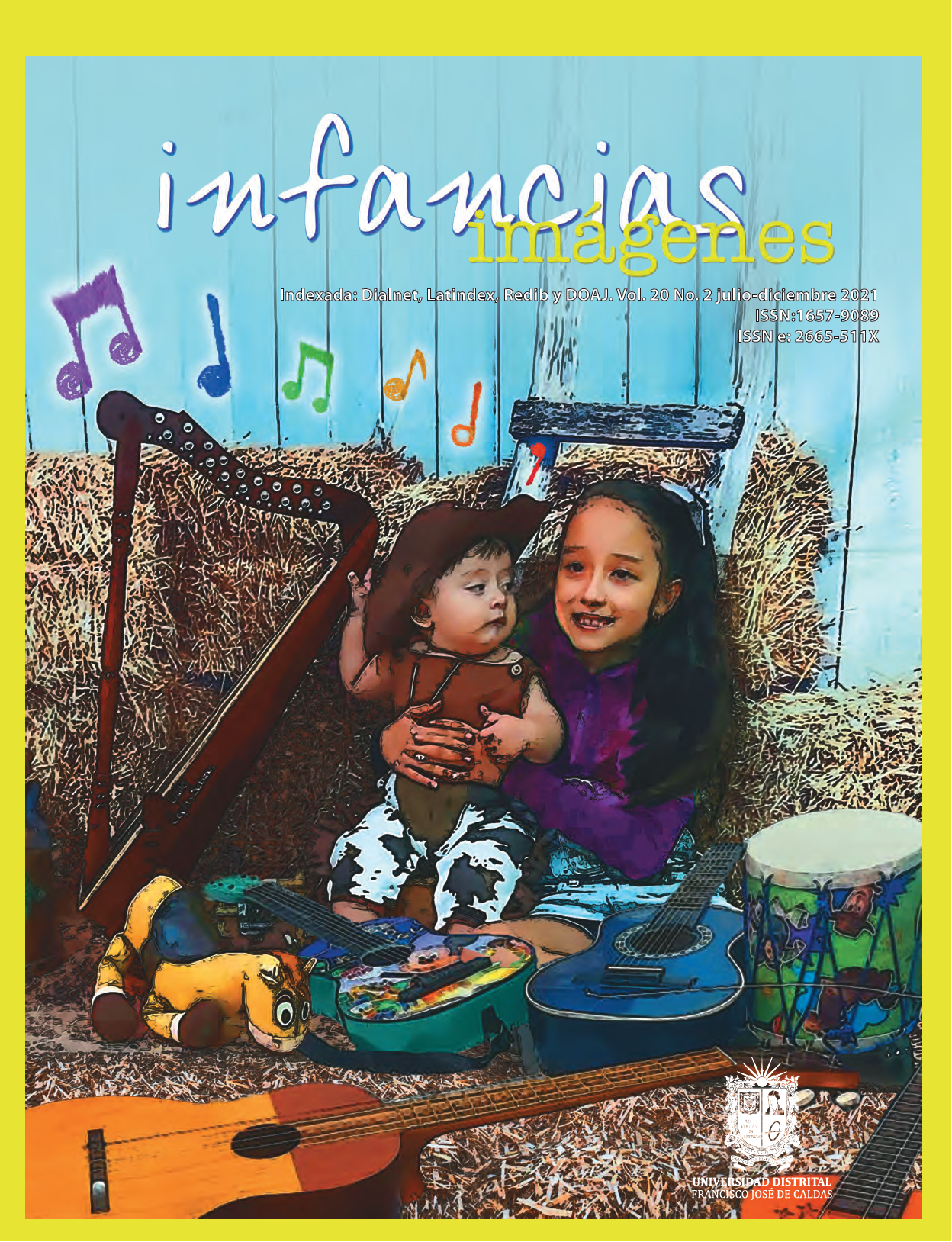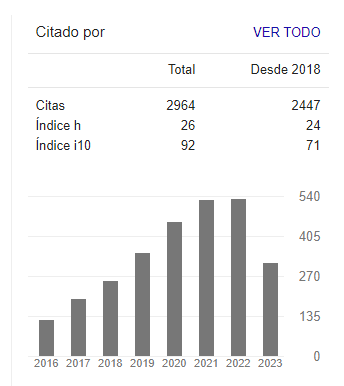DOI:
https://doi.org/10.14483/16579089.16297Published:
2021-12-30Issue:
Vol. 20 No. 2 (2021): julio-diciembreSection:
Imágenes de InvestigaciónLa relación entre actividad atencional en bebés y prácticas educativas de maestras
The Relationship between Attention Activities in Babies and Teachers’ Educational Practices
Keywords:
attention, childhood, development, early childhood education, psychology (en).Keywords:
atención, desarrollo, educación inicial, infancia, psicología (es).Downloads
Abstract (es)
El presente trabajo tuvo como propósito reconocer y comprender, desde el paradigma cualitativo, la manera en que dos bebés (de 9 y 10 meses) despliegan la actividad atencional en dos instituciones de cuidado para la primera infancia en Cali, Colombia, así como la manera en que las maestras favorecen o no sus secuencias atencionales. Para cumplir con este objetivo, se escogió una orientación analítica vinculada a la estesis, como posibilidad de apertura al mundo, y la atencionalidad concebida como una actividad. Se realize un microanálisis del registro fílmico de una escena en cada institución relacionado con situaciones espontáneas. Los resultados mostraron que los bebés logran agenciar la búsqueda de objetos de interés, pero las intervenciones hechas por las maestras no siempre favorecen que se complete la secuencia atencional para llegar a la exploración. Por ello, para favorecer el enriquecimiento de sus procesos atencionales, el adulto que acompaña ha de ser sensible y responsivo a las necesidades del bebé.
Abstract (en)
The purpose of this work was to recognize and understand, from the qualitative paradigm, the way in which two babies (9 and 10 months old) engage in attention-related activities in two early childhood care institutions in Cali, Colombia, as well as the way in which teachers favor or not their attentional sequences. To this effect, an analytical orientation linked to esthesis was selected as an opportunity to open up to the world, as well as attentionality conceived as an activity. A microanalysis was performed on the filmic records of a scene at each institution, which was related to spontaneous situations. The results showed that babies can achieve agency in the search for objects of interest, but the teachers’ interventions do not always favor the completion of the attentional sequence to reach exploration. To favor the enrichment of their attentional processes, the accompanying adult must be sensitive and responsive to the baby's needs.
References
Adamson, L., y Bakeman, R. (1991). The development of shared attention in infancy. In R. Vasta (ed.), Annals of Child Development, viii. London: Jessica Kingsley Publishers, p.1–41.
Bruner, J. S. (1975). From communication to language: A psychological perspective. Cognition, 3(3), 255–287. https://doi.org/10.1016/0010-0277(74)90012-2
Cantor, J., Guerrero, P., y Ospina, V. (2017). Trayectorias de agenciamiento de niños menores de dos años: una propuesta para el análisis de interacciones cotidianas en contextos de cuidado. Revista Psicología desde el Caribe, 34(3), 1-14.
Cassidy, D. J., King, E. K., Wang, Y. C., Lower, J. K., and Kintner-Duffy, V. L. (2017). Teacher work environments are toddler learning environments: teacher professional well-being, classroom emotional support, and toddlers’ emotional expressions and behaviours. Early child development and care, 187(11), 1666-1678. https://doi.org/10.1080/03004430.2016.1180516
Castle, S., Williamson, A. C., Young, E., Stubblefield, J., Laurin, D., and Pearce, N. (2016). Teacher-child interactions in early head start classrooms: Associations with teacher characteristics. Early Education and Development, 27(2), 259-274. https://doi.org/10.1080/10409289.2016.1102017
Di Paolo, E. A., Rohde, M., y Iizuka, H. (2008). Sensitivity to social contingency or stability of interaction? Modelling the dynamics of perceptual crossing. New Ideas in Psychology, 26(2), 278–294. https://doi.org/10.1016/j.newideapsych.2007.07.006
Español, Silvia (2017). Si queremos saber cómo sopla el viento podemos mirar la arena. Pensar el desarrollo psicológico observando el movimiento. En La segunda persona y las emociones. SADAF.
Fernández, A. (2011). La atencionalidad atrapada. Estudios sobre el desarrollo de la capacidad atencional. Nueva Visión.
Gibson, E. J., y Rader, N. (1979), ‘Attention: the perceiver as performer’, en G. A.Hale and M. Lewis (eds.), Attention and Cognitive Development. Plenum Press, 1–21.
Guerrero, P. A. (2014). Calidad de las interacciones educativas con menores de tres años: una exploración sobre la atención conjunta en jardines infantiles [Tesis de maestría]. Universidad de los Andes.
Hobson, P. (1995). El autismo y el desarrollo de la mente. Alianza.
Ibañez, M. I., Rosemberg, C. R., Migdalek, M. J., and Giordano, C. (2021). La configuración de los intercambios en el entorno lingüístico del jardín maternal. Revista Del IICE, 49, 73-92. http://revistascientificas.filo.uba.ar/index.php/iice/article/view/10449
Kipp, M. (2008). Spatiotemporal Coding in ANVIL. Proceedings of the 6th international conference on Language Resources and Evaluation (LREC-08).
Levin, E. (2010). La experiencia de ser niño. Plasticidad simbólica. Nueva Visión.
Lewkowicz, D. J., and Kraebel, K. (2004). The value of multimodal redundancy in the development of intersensory perception. In G. Calvert, C. Spence, and B. Stein (Eds.). Handbook of multisensory processing (pp. 655–678). MIT Press.
Markowitz, A. J., Sadowski, K., Hamre, B. (2021). Teacher Education and the Quality of Teacher-Child Interactions: New Evidence from the Universe of Publicly-Funded Early Childhood Programs in Louisiana. Early Education and Development,33(2), 290-308. https://doi.org/10.1080/10409289.2021.1888036
Mandoki, K. (2006). Estética cotidiana y juegos de la cultura. Siglo XXI Editores.
Martínez, M., Español, S., Igoa, J. M. (2021). Recognition of intersensory relationships based on duration in infants four, seven and 10 months old. Journal for the Study of Education and Development, 45(1), 81-115. https://doi.org/10.1080/02103702.2021.1925457
Mundy, P. (2018). A review of joint attention and social‐cognitive brain systems in typical development and autism spectrum disorder. European Journal of Neuroscience, 47(6), 497-514. https://doi.org/10.1111/ejn.13720
Munévar, M. (2013). Concepciones sobre la infancia en agentes educativos de hogares infantiles de ICBF [Tesis de grado]. Universidad Icesi.
Narodowski, M., y Snaider, C. (2017). ¿Bebés en las escuelas? Infancias hiperescolarizadas en una cultura prefigurativa. Revista Latinoamericana de Ciencias Sociales, Niñez y Juventud, 15(1), 45-57.
Pérez-Jiménez, M. Á., y Suárez-Acevedo, C. (2018). Intención y Experiencia: retos para una Teoría de la Atención Conjunta. Discusiones Filosóficas, 19(32), 97-115.
Reddy, V. (2005). Before the third element. Understanding attention to self. En Joint attention: comunication and other minds (pp. 85-106). Oxford University Press. https://doi.org/10.1093/acprof:oso/9780199245635.003.0005
Rochat, P. (2004). El mundo del bebé. Morata.
Tomasello, M. (1999). The cultural origins of human cognition. Harvard University Press.
Zabala, V. (2013). Interacciones tempranas entre adulto y bebé en contextos institucionales [Tesis de grado]. Universidad Icesi.
How to Cite
APA
ACM
ACS
ABNT
Chicago
Harvard
IEEE
MLA
Turabian
Vancouver
Download Citation
License
Copyright (c) 2022 Viviana Riascos Cataño, Lucas Gustavo Gago Galvagno, Vivian Ospina Tascón

This work is licensed under a Creative Commons Attribution-NonCommercial-ShareAlike 4.0 International License.
Reconocimiento – NoComercial – CompartirIgual (by-nc-sa): No se permite el uso comercial de la obra original, las obras derivadas deben circular con las mismas condiciones de esta licencia realizando la correcta atribución al autor.
Esta obra está bajo una licencia de Creative Commons Reconocimiento-NoComercial-CompartirIgual 4.0 Internacional






1.png)

